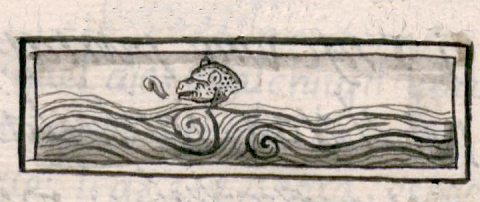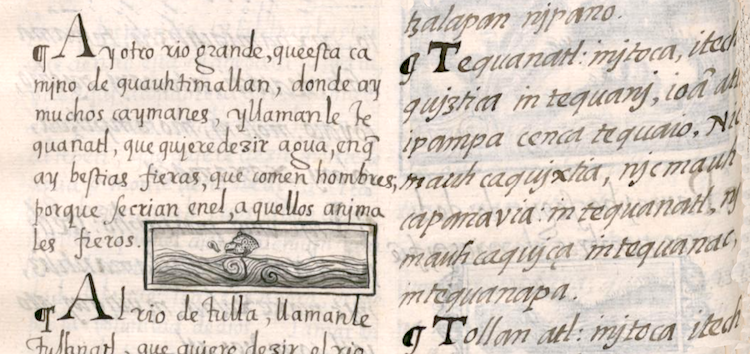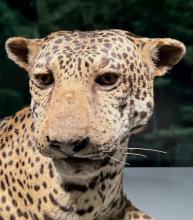Tecuanatl (FCbk11f224v)
This is a compound glyph for Tecuanatl, the name of a river. It appears on folio 224 verso in Book 11, “Earthly Things,” of the General History of the Things of New Spain, also known as the Florentine Codex. The compound glyph consists of an image of the head of a wild animal (tecua(ni)) (a generic term connoting ferocity and usually classed as something that bites people) floating atop a stream of rushing water (atl). It is shown in profile, facing left. The animal’s head is feline in nature and spotted, possibly indicating an ocelotl or jaguar. A speech scroll issuing out of the animal’s mouth has nothing directly to do with the name, but indicates that his wild animal is roaring or making a similar sound. The swirling water seems to be a live thing, too. The image is painted in blacks and grays, rather than in color.
Robert Haskett
According to the text of the Book 11 entry, this is “large river…where there are many caimans, and they call it Tecuanatl, which means water in which there are ferocious beasts, which eat people, because those ferocious animals are raised in it.” It is interesting to note that, rather than picturing a crocodilian creature in the glyph, the more generic “wild animal” tecuani (though fashioned as a feline, it must be said) is used instead. This is undoubtedly something that should be tracked as more examples are found in other glyphs. As far as the “people-biting” meaning of the Nahuatl term is concerned, and while whoever translated the word into Spanish in the Florentine Codex glossed it as meaning “an animal that eats people,” John Sullivan has suggested an alternate reading. arguing that “there is no word for animal in Nahuatl. Nahua speakers use tecuani to name a certain class of living creatures: non-humans that bite. Tecuani does have its root in the verb cua, to eat. But another sense of cua is to bite, and this is the meaning of tecuani, a people biter. Obviously there are some tecuani that, aside from biting people, can also eat them, but this isn't the sense of the word” (2012; see the Online Nahuatl Dictionary).
Robert Haskett
Tequanatl
Tecuanatl
Robert Haskett
1577
Robert Haskett
The speech scroll indicating that the tecuani is making a noise could be seen as a third element, or might be part of the "wild animal" sense, instead. Perhaps it stands for the rushing or roaring sound a fast-flowing river makes.
water, agua, river, rio, wild animal, animal salvaje
Photograph by Stephanie Wood, Museo de Templo Mayor, 15 February 2023.

tecuani, ferocious wild animal, literally one that bites people, https://nahuatl.wired-humanities.org/content/tecuani
cua, to eat or to bite, https://nahuatl.wired-humanities.org/content/cua
a(tl), water, a body of water, such as a lake, river, or ocean, https://nahuatl.wired-humanities.org/content/atl
El Río de Animales Salvajes
Robert Haskett
Library of Congress, https://www.loc.gov/item/2021667856/.
The Library of Congress is unaware of any copyright or other restrictions in the World Digital Library Collection. Absent any such restrictions, these materials are free to use and reuse. Researchers are encouraged to review the source information attached to each item. If you do publish anything from this database, please cite the Visual Lexicon of Aztec Hieroglyphs.





